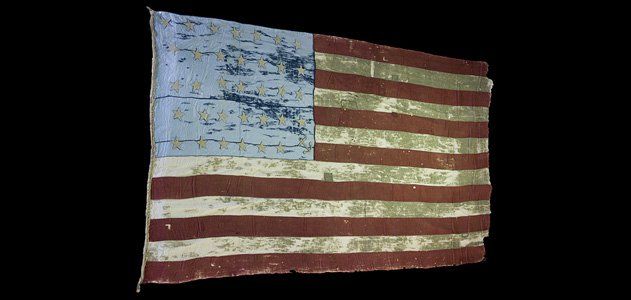The Flag, the Medal of Honor, and the President

[This piece was originally published in the West Virginia Record in October, 2017]
During the Civil War, flags on the battlefield had enormous tactical and strategic importance. Regimental flags allowed soldiers to know the position of their units, and which direction they should be moving to keep up with it. Flag bearers carried them at enormous risk to their lives. Since the entire point of carrying them was to be highly visible, and because the flags were of great use in directing the battle, flag bearers were easily and frequently targeted with gunfire and by artillery.
At the battle of Gettysburg, the United States awarded some sixty-four Medals of Honor. Fully half of those medals were for conspicuous gallantry directly related to the carrying, or capture, of flags on the battlefield. As an example, Sergeant Major William Hincks’ (14th Connecticut) Medal of Honor citation reads as follows:
During the high water mark of Pickett’s Charge on July 3rd. the colors of the 14th Tennessee Infantry C.S.A. were planted 50 yards in front of the center of Sgt. Maj. Hincks’ regiment. There were no Confederates standing near it but several were lying down around it. Upon a call for volunteers by Major Ellis to capture this flag, this soldier and two others leaped the wall. One companion was instantly shot. Sgt. Maj. Hincks outran his remaining companion running straight and swift for the colors amid a storm of shot. Swinging his saber over the prostrate Confederates and uttering a terrific yell, he seized the flag and hastily returned to his lines. The 14th Tennessee carried twelve battle honors on its flag. The devotion to duty shown by Sgt. Maj. Hincks gave encouragement to many of his comrades at a crucial moment of the battle.
Hincks’ heroism could not have come at a more important moment. Pickett’s Charge is by most accounts the turning point of the Civil War, and its failure portended the ultimate defeat of the confederate rebellion against the United States. It is fitting that the next sunrise came on the Fourth of July.
Charles Veale (4th U.S. Colored Infantry) saw two of his fellow soldiers killed before his eyes carrying the star-spangled banner, so he charged into harm’s way to pick it up. His citation reads simply: “[s]eized the national colors after 2 color bearers had been shot down close to the enemy's works, and bore them through the remainder of the battle.” It sounds easy when you say it like that, but just imagine.
Modern military tactics have made actions like Hincks and Veale’s less common and less necessary, but the tradition of reverence for our flag doesn’t come out of thin air. Many American soldiers have died for our flag, not just in the figurative sense of dying in the service of their country, but literally died displaying it, carrying it, or rescuing it from danger.
How shall we honor them?
It has become commonplace to observe that since the Civil War itself, the country has never been more divided. Last weekend, widespread protests occurred among NFL teams, with players kneeling, locking arms, or skipping the anthem altogether and waiting in the locker room for the game to begin. While we’ve had protests all year long – millions marched in the Women’s March back in January – these latest protests seem to have struck the rawest nerves.
With fewer and fewer ways to escape from politics, it caught up with all of us on a football Sunday and embroiled the NFL in national controversy. The President has said that “the only way out for them is to set a rule that you can't kneel during our National Anthem.” With all the respect that is due the President, that would not be the American way.
We do not compel displays of patriotism in this country. Forcing people to pledge allegiance or loyalty has always been a feature of the despotic regimes we have opposed around the world. In North Korea, you pledge allegiance or go to prison. In Mao’s China, your unquestioned loyalty to the government was the price of staying alive. Hitler likewise executed civil servants who did not swear fealty to his government.
The United States does things a different way. In 1943, the Supreme Court of the United States held that schools could not expel children who declined to stand for, or say, the Pledge of Allegiance. Doing so violated their rights under the First and Fourteenth Amendments to the United States’ Constitution. Justice Jackson explained:
The case is made difficult not because the principles of its decision are obscure, but because the flag involved is our own. Nevertheless, we apply the limitations of the Constitution with no fear that freedom to be intellectually and spiritually diverse or even contrary will disintegrate the social organization. To believe that patriotism will not flourish if patriotic ceremonies are voluntary and spontaneous, instead of a compulsory routine, is to make an unflattering estimate of the appeal of our institutions to free minds.
No one has to salute the flag in America, and that is why we know that it is worth saluting. The right to protest the government and resist injustices is a right we founded the country to preserve. Of course, no one is required to agree with anyone else’s protest, or like it, or like them. Boo if you want and burn the jerseys if they are your own. We cherish those freedoms too.
Nothing would disgrace our flag more than forcing anyone to honor it. We could not heap any greater insult on our honored dead than to use their sacrifice to justify tyrannical behavior, loyalty oaths, or compulsory displays of what could only then be a false patriotism. In the Battle Hymn of the Republic, union soldiers carrying our flag sang “as He died to make us holy, let us die to make men free.”
It’s still a free country. Whatever else we do, let’s keep it that way.

